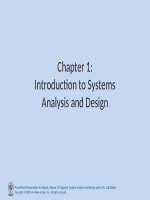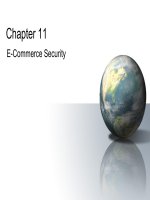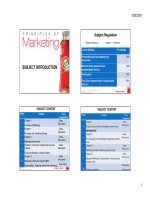Lecture E-Commerce - Chapter 1: E Commerce - Business technology and society
Bạn đang xem bản rút gọn của tài liệu. Xem và tải ngay bản đầy đủ của tài liệu tại đây (974.38 KB, 51 trang )
CSC 330 E-Commerce
Teacher
Ahmed Mumtaz Mustehsan
GM-IT CIIT Islamabad
Virtual Campus, CIIT
COMSATS Institute of Information Technology
T1-Lecture-1
E Commerce:
Business Technology and Society
Chapter-1
T1-Lecture-1
For Lecture Material/Slides Thanks to:
Copyright © 2010 Pearson Education, Inc
Objectives:
Introduction to CSC 330 E Commerce
Course Objectives; Outline,; Text Books and Reference
Books,.
Delivery of the course and grading policy.
e-commerce today
E Commerce and social networking.
E-commerce trends, 2010-2011 and onwards.
Define e-commerce and describe how it differs from ebusiness.
T1-Lecture-1 CSC330 E Commerce
Ahmed Mumtaz Mustehsan
Copyright © 2010 Pearson Education, Inc
Introduction to Instructor’s Profile
Course Instructor
Ahmed Mumtaz Mustehsan
General Manager-IT
COMSATS Institute of Informational Technology, Islamabad
Qualifications:
Master in Computer Sciences (1979-81)
Quaid-e-Azam university Islamabad.
Area of Expertise &
Specialization:
Satellite Image Processing and GIS
Specialize at SEP, La defance PARIS, France, (1986-1989 Informal)
Experience:
32 years of experience in the field of IT industry, Education and R & D
Served on:
Different Reputable Posts at Middle and Top Management at National and
International Organizations
AS:
Scientific Officer, PAEC, Islamabad.
In-charge CTC, UGC, COBS, PAEC, H-9, Islamabad
System Manager, Jafrana Limited, Canada
Manager Data Processing, SUPARCO
Director, Satellite Ground Station, SUPARCO
Associate Professor, University of Lahore
Head Department of Computer Sciences, CIIT
General Manager IT, CIIT, Islamabad.
Hands on:
Development of System software, Information systems and Interactive system.
Man machine interface.
Assembly , FORTRAN, COBAL, Java and C Languages.
Introduction to:
CSC 330 E-Commerce
Credit Hours 4( 3,1)
3 hours Teaching plus 3 hours Lab
For Lecture Material/Slides Thanks to: Copyright © 2010 Pearson Education, Inc
Policy: Delivery, Evaluation & Grading:
Delivery :
•The course will be imparted through two tracks
Track-1 (T1) comprising theoretical components of
the course and Track-2 (T2) covering practical
expects comprising tools like HTML, XML, Java
Scripts, PHP and ASP etc.
•T2 will further be covered through Lab exercises
and assignments.
Note: The students are directed to keep the pace
with both the tracks. The assessment will be based
upon T1 as well as T2.
T1-Lecture-1 CSC330 E Commerce
Ahmed Mumtaz Mustehsan
Policy: Delivery, Evaluation &
Grading……
Evaluation & Grading :
Quizzes
Assignments
Graded Discussions
4
4
4
Midterm Examination
2
First Sessional
Second Sessional
Terminal Examination
1
1
1
T1-Lecture-1 CSC330 E Commerce
Ahmed Mumtaz Mustehsan
10%
10%
5%
12.5%
12.5%
50%
Course Objectives
To
understand the role of ecommerce in world
economy.
Introduction & clear understanding of all types of ecommerce, associated technologies & their integration
& effective interaction among these technologies.
Design
& implementation of e-commerce applications
and associated hardware, network & security
infrastructure. Thorough understanding of the
payment systems & methods.
Business,
financial, marketing & behavioral model for
ecommerce business.
Marketing
To
& social impacts of ecommerce.
gain a practical
experience
in some of the
Ahmed Mumtaz Mustehsan
Copyright © 2010 Pearson Education, Inc
ecommerce techniques.
T1-Lecture-1 CSC330 E Commerce
Text Book
E-Commerce: Business Technology and Society
Kenneth c. Laudon, Caral G. Traver 7th edition
ISBN-10: 0273-75084-4
ISBN-13: 978-0-273-75084-0
Edition: 7
Pub. Date: 2011
Publisher: Prentice Hall
E-Commerce: Business Technology and Society
Kenneth c. Laudon, Caral G. Traver 6th edition
ISBN:0136100570
ISBN-13:9780136100577
Edition:6
Pub. Date: November 2009
Publisher: Prentice Hall
Note: The older editions along with lecture material will also be sufficient for this course
T1-Lecture-1 CSC330 E Commerce
Inc
Ahmed Mumtaz Mustehsan
Copyright © 2010 Pearson Education,
Reference Book
The Complete E- Commerce
Book Design, Build, & maintain
a successful Web Based Business.
REYNOLDS
2nd Edition
Also follow the references provided in the lectures and E-Commerce articles
published.
T1-Lecture-1 CSC330 E Commerce
Inc
Ahmed Mumtaz Mustehsan
Copyright © 2010 Pearson Education,
Course Outline
T1: Track-I: will be based upon the following text books
T2: Track-2:
will cover HTML, XML, Java Script, PHP
and ASP Technologies
Note; Detailed outline and Lecture Breakdown is available at Course web site.
T1-Lecture-1 CSC330 E Commerce
Inc
Ahmed Mumtaz Mustehsan
Copyright © 2010 Pearson Education,
Facebook:
The New Face of E-Commerce?
The Facebook is considered to be a new face
for the E-Commerce as there are number of
applications available for the users that enable
them to interact through the online channels
and buy various new products.
Do you use Facebook?
sure most of you do!!
Why?
Facebook today (4 October , 2012)) announced that it
has passed the 1 billion user milestone. This makes
Facebook the first social network to reach the 10-figure
mark; one out of every seven individuals on the planet
now use the service.
T1-Lecture-1 CSC330 E Commerce
Ahmed Mumtaz Mustehsan
Copyright © 2010 Pearson Education, Inc
Facebook:
The New Face of E-Commerce?
Have you purchased anything based on an advertisement at
internet?
sure most of you did !!
Why?
“Big Data in Today’s Business and Technology
Environment”
2.7 Zetabytes of data exist in the digital universe today.
IDC Estimates that by 2020,business transactions on the
internet- business-to-business (B2B) and business-toconsumer (B2C) – will reach 450 billion per day.
Facebook stores, accesses, and analyzes 30+ Petabytes
of user generated data.
More than 5 billion people are calling, texting, tweeting and
browsing on mobile phones worldwide.
T1-Lecture-1 CSC330 E Commerce
Ahmed Mumtaz Mustehsan
Copyright © 2010 Pearson Education, Inc
Facebook:
The New Face of E-Commerce?
Are you concerned about the privacy of the
information you have posted on Facebook?
sure most of you are least bothered !!
Why?
Default Old policy of facebook:
“ Only your friends will know about your face
book profile”
New Default Policy of facebook:
“ no privacy”
T1-Lecture-1 CSC330 E Commerce
Ahmed Mumtaz Mustehsan
Copyright © 2010 Pearson Education, Inc
E-commerce Trends 2010-2011 and onwards:
Business, Technology and Society
Business
New
“social e-commerce” platform is emerging based upon
networks and support by advertising.
Social and mobile advertising platforms show strong growth.
Online business continues to strengthen profitability by
referring business model and relying the capabilities of internet.
Retail e-commerce resumes double digit growth 12.5%
annually 6 times faster than traditional retail.
Twitter continues to grow
The bandwidth of internet grows especially for entertainment
with the result there is explosive growth in online video viewing.
Small business and entrepreneurs continue to flood into ecommerce marketplace, utilizing infrastructure created by
industrial giants such as Apple, Facebook, Google, Amazon,
eBay.
T1-Lecture-1
.. etc ..CSC330
etc E Commerce
Ahmed Mumtaz Mustehsan
Copyright © 2010 Pearson Education, Inc
E-commerce Trends 2010-2011 and onward
Technology
Wireless
Internet connections (Wi-Fi, Wi-Max, and 3G
telephone) grow rapidly.
A mobile computing and communications platform based on
iphones, BlackBerries, and other smartphones, netbooks,
computers and iPad becomes a reality and begins to challange
PC.
Over million Apps (October 2013) in Apple’s App Store, a new
model of delivering services and software.
Bandwidth prices fall as telecommunications companies
expand their capacities with new technologies.
Computing and networking component prices continue to fall.
Cloud computing and web services expand B2B opportunities
and significantly reduce the cost of Infrastructure needed for ecommerce.
Real time advertising becomes a reality as firms gain in
computing power and database speed.
T1-Lecture-1
The global
population
using
theMustehsan
internet Copyright
continues
to expand.
CSC330
E Commerce Ahmed
Mumtaz
© 2010 Pearson
Education, Inc
E-commerce Trends 2010-2011 and onward
Society
Consumer
and user generated contents at Social networks,
Tweets, Blogs, wikis and virtual lives keep growing providing self
publishing forums.
Newspapers and other traditional media adopt online,
interactive models.
Social networks encourage self disclosures while threating
privacy.
Traditional media continue to loose subscribers as online
interactive models gaining popularities.
Copyrights conflicts are slowly being settling down as an
informal understanding between internet users and copyright
owners is being developed.
Explosive growth in the use of entertainment media continues.
Participation of adults in social networks such as facebook is
increasing.
Internet security worsens due to malware spams and identify
theft
occurrences.
T1-Lecture-1
CSC330 E Commerce Ahmed Mumtaz Mustehsan
Copyright © 2010 Pearson Education, Inc
The First 30 Seconds
first
ten years of e-commerce represents just the
beginning—also called the first thirty seconds of the ecommerce revolution.
Technologies continue to evolve at exponential rates
◦Disruptive business change
◦New opportunities
The twenty-first century will be the age of a digitally
enabled social and commercial life, the outlines of
which we can barely perceive at this time.
The next five years hold out extraordinary
opportunities as well as risks for new and traditional
business as it offers the possibility of extraordinary
gains in social wealth as the digital revolution is taking
place.
T1-Lecture-1 CSC330 E Commerce
Ahmed Mumtaz Mustehsan
Copyright © 2010 Pearson Education, Inc
US Census Bereau 2008 e-Store Report
Retail E-Commerce (Non-Travel) Growth Rates
Excludes Auctions, Autos and Large
Corporate Purchases
Total U.S. – Home/Work/University Locations
Source: comScore, Inc.
Quarter
E-Commerce
Spending ($
Millions)
Y/Y Percent Change
Q1 2007
Q2 2007
Q3 2007
Q4 2007
Q1 2008
Q2 2008
Q3 2008
Q4 2008
Q1 2009
Q2 2009
Q3 2009
Q4 2009
$27,970
$27,176
$28,441
$39,132
$31,178
$30,581
$30,274
$38,071
$31,031
$30,169
$29,552
$39,045
17%
23%
23%
19%
11%
13%
6%
-3%
0%
-1%
-2%
3%
T1-Lecture-1 CSC330 E Commerce
Ahmed Mumtaz Mustehsan
Copyright © 2010 Pearson Education, Inc
What is E-commerce?
Use
of Internet and Web for business transection.
More
formally:
◦Digitally enabled commercial transactions
between and among organizations and
individuals.
T1-Lecture-1 CSC330 E Commerce
Ahmed Mumtaz Mustehsan
Copyright © 2010 Pearson Education, Inc
E-commerce vs. E-business
E-business:
◦Digital enablement of transactions and
processes within a firm, involving information
systems under firm’s control.
◦Does not include commercial transactions
involving an exchange of value across
organizational boundaries
T1-Lecture-1 CSC330 E Commerce
Ahmed Mumtaz Mustehsan
Copyright © 2010 Pearson Education, Inc
The Difference Between E-commerce
and E-Business
Copyright © 2002 Pearson Education, Inc.
Slid
e 122
Why Study E-commerce?
E-commerce
technology is different, more powerful
than previous technologies
E-commerce
bringing fundamental changes to
commerce. Introduce new buzz words:
Marketplace: a physical place you use for business
transection.
Marketspace: marketplace extended beyond traditional
boundaries; removed from temporal and geographic
locations.
Information asymmetry: any disparity in relevant market
information among parties in a transection.
T1-Lecture-1 CSC330 E Commerce
Ahmed Mumtaz Mustehsan
Copyright © 2010 Pearson Education, Inc
Unique Features of E-commerce Technology
1.
2.
3.
4.
5.
Ubiquity: Available everywhere and all the time, i.e.
Internet/Web technology is available everywhere; at work,
at home, and elsewhere via mobile devices and round the
clock (anytime).
Global reach: The technology reaches across national
boundaries, around the earth.
Universal standards: There is one set of technology
standards, namely Internet standards as compared to
different standards followed by different nations.
Information richness: unlimited information of a product is
available through Video, audio, and text messages at
internet and social media.
Interactivity: The technology works through interaction with
the user. One shopkeeper can handle large number of
clients simultaneously at internet as compared to traditional
e-commerce.
T1-Lecture-1 CSC330 E Commerce
Ahmed Mumtaz Mustehsan
Copyright © 2010 Pearson Education, Inc
Unique Features of E-commerce Technology
Information density: The technology reduces information
costs and raises quality through social media. The
authenticity achieved through public domain.
6. Personalization/customization: Personalization: The
targeting of marketing messages to specific individuals by
adjusting the message to a person's name, interests, and
past Purchases. (Customization) Changing the delivered
product or service based on a user's preferences or prior
behavior
7. Social technology: user content generation and social
networking. The e-commerce technologies have evolved
users to create and generate contents in the form of web,
Facebook pages, text, video, music and photos with
worldwide communities.
5.
T1-Lecture-1 CSC330 E Commerce
Education, Inc
Ahmed Mumtaz Mustehsan
Copyright © 2010 Pearson
![effortless e-commerce with php and mysql [electronic resource]](https://media.store123doc.com/images/document/14/y/sy/medium_syr1401465529.jpg)








